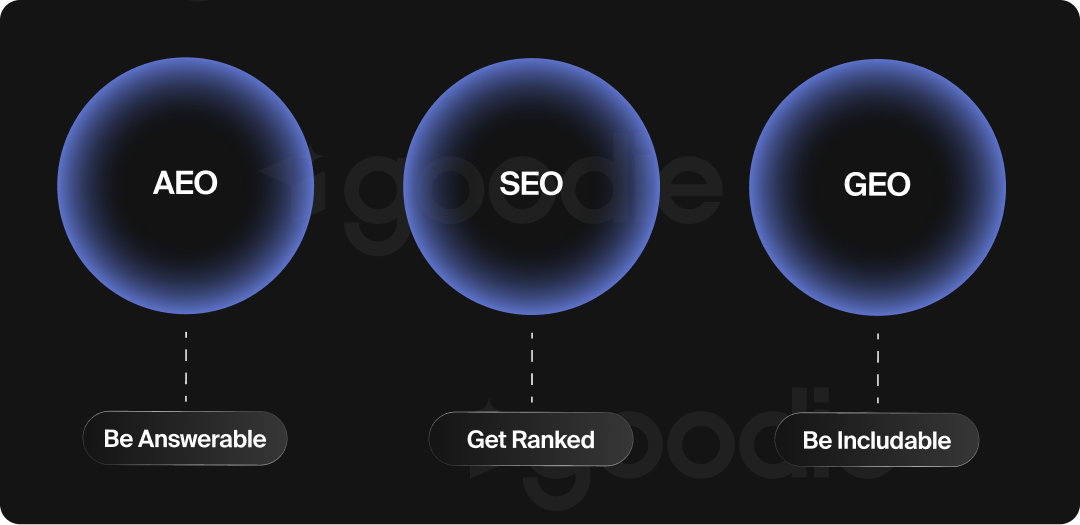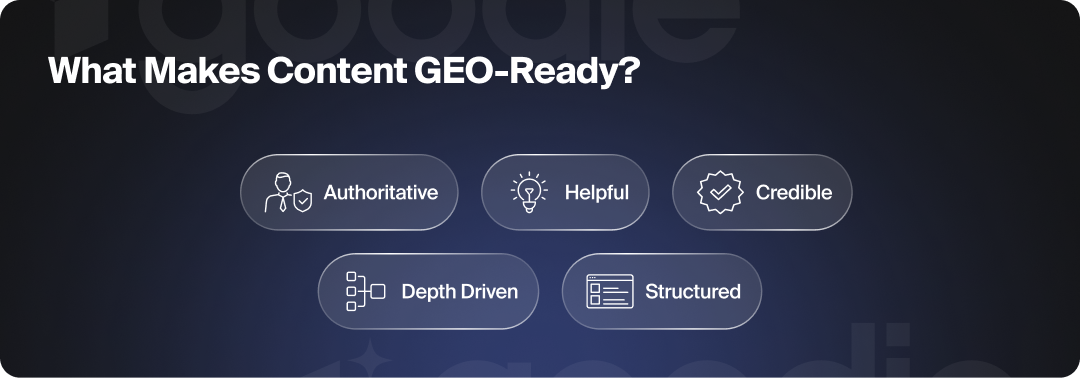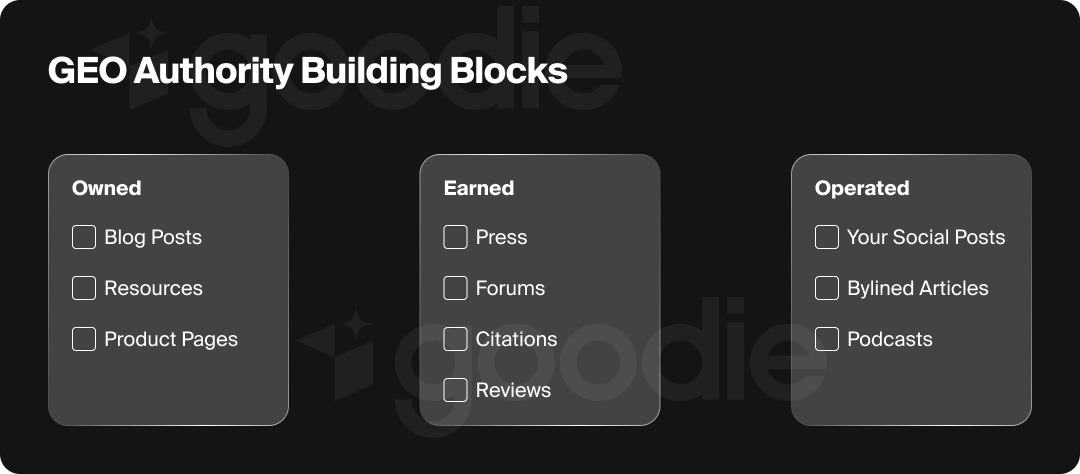

AI doesn’t care how pretty your website is. If it doesn’t trust you, you don’t exist.
That’s the cold reality of generative search. We’ve moved past the days of fighting for position #1 on Google and into an era where large language models decide who gets included, who gets cited, and who gets ghosted.
This is where Generative Engine Optimization (GEO) comes in. Unlike traditional SEO, which is all about rankings, or AEO, which is about making your content answerable, GEO is about being includable: showing up as a trusted source inside AI responses.
And the single biggest factor determining whether you make it or not is authoritative content. Basically: if you want to show up in the answers people actually see, you’ll need to build authority that LLMs can’t ghost.

Generative Engine Optimization is the next evolution of search optimization, built for a world where users aren’t just scrolling through blue links; instead, they’re getting full answers generated by AI.
At the heart of it, GEO in content writing means creating material that Large Language Models (LLMs) can understand, trust, and cite. Instead of simply optimizing for Google’s algorithm, you’re optimizing for AI-driven environments like Google’s AI Overviews, Perplexity, Gemini, and even ChatGPT when it pulls live web data.
Where SEO asks: “How do I get my page to rank?”
And AEO asks: “How do I make my content answerable?”
GEO asks: “How do I make my content includable in AI responses?”
That last piece is key. Generative engines don’t spit out a list of links; they weave together synthesized answers from sources they trust. If your brand isn’t among those sources, you’re invisible.
So, GEO content writing is about building authority, structure, and depth into your content so it becomes the kind of material LLMs pull into their outputs. That means:
It’s less about chasing algorithms and more about positioning your brand as the definitive voice in your niche; because in a generative search world, only the authoritative survive.
If you’ve been around the SEO block, you’ve probably heard of AEO (Answer Engine Optimization), which is about optimizing your content so it can appear in quick answers, featured snippets, or even voice search results.
GEO (Generative Engine Optimization), on the other hand, is about being includable. Generative engines don’t just grab a single fact; they build multi-sentence, multi-perspective responses stitched together from multiple sources they trust.
Here’s the difference in plain terms:
Both AEO and GEO reward authoritative content, but the stakes shift:
👉 Bottom line: AEO makes you answerable; GEO makes you unavoidable.
So if GEO is about being includeable, then GEO content is the material that is going to earn you a seat at that table. It’s optimized for keywords, but also credibility, context, and clarity.
Here are the hallmarks of strong GEO content:
Think of it like this: SEO content talks to Google’s crawler; GEO content talks to the AI model. It’s still optimized for humans first, but it’s structured so machines can understand and reuse it accurately.

For example, if you’re in Fintech:
GEO content should be authoritative, answerable, and architected for AI. Because here’s the kicker: all of the structure, schema, and clever formatting in the world won’t save you if your content isn’t authoritative. In a generative search landscape, authority isn’t just a “nice to have”; it’s the deciding factor in whether your brand gets included at all.

In SEO, authority has always been a ranking signal. In AEO, it’s what earns you the featured snippet or the spoken answer. But in GEO, authority is the whole game.
Here’s why: generative engines don’t “rank” content in a traditional sense. They synthesize answers based on the sources they consider reliable enough to stitch into a response. If you’re not on that shortlist of trusted voices, you don’t just lose a position. You disappear completely.
Think about how an AI Overview or Perplexity response is built:
Authority is what gets you onto that shortlist.
Without it, your content may be technically correct, but the model won’t risk surfacing it. Generative engines are probabilistic, meaning they rely on patterns, trust signals, and digital reputation. The more consistently authoritative your brand appears across the web, the more likely you are to be pulled into those outputs.
A few examples of how this plays out in practice:
The stakes are higher in GEO because inclusion isn’t infinite. There’s no page two of an AI Overview. You’re either part of the narrative, or you’re invisible.
If authority is the currency of GEO, the question you’re (hopefully) asking is how to actually earn it. Spoiler: it isn't keyword stuffing or pumping out thin content. Authority is built through depth, trust signals, and consistency; the things that make generative engines (and humans) see your brand as the real deal.
Here’s the framework:
Search engines have always rewarded topical depth, but in GEO, it’s a non-negotiable.
For example, instead of just creating an article on “How to Calculate Loan Interest,” build a full cluster that includes APR breakdowns, explains compounding interest with examples, an interactive loan calculator, and FAQs.
By offering a user everything they could possibly need to know about a given topic, you demonstrate your expertise to both users and generative engines.
E-E-A-T has long been an important SEO principle, but with AI in the mix, we recommend the acronym add an “H” for helpfulness. Helpfulness, Experience, Expertise, Authoritativeness, and Trustworthiness are all criteria for survival in AI search. Here’s what your content has to include:
Generative engines lean heavily on these kinds of trust signals when deciding whether or not your sources are going to make the cut.
People often have this misconception that AI “reads” the same way that we do; like a researcher diving into different sources to learn about a topic. However, it doesn’t work this way. Instead, they parse (analyze input data and structure). Here’s what your content needs:
The easier you make it for AI to lift and repurpose your content, the more likely your content is to get included in AI outputs.
Authority isn’t built in a vacuum. Generative engines look across the web for reinforcements.
Think of it like building a digital paper trail of credibility. When your friends recommend a restaurant they really like, you feel more willing to try it, right? The same goes for AI. The more places your expertise shows up in, and gets recommended, the harder it is for engines to ignore you.
GEO isn’t handing out awards for one-hit wonders. You need to be consistent. This means you should:
In GEO, your digital footprint is your reputation. And reputations don’t get built overnight.
And building authoritative content may be step one, but authority alone doesn’t guarantee inclusion if your content isn’t also optimized for how generative engines actually process and surface information. This is where GEO-specific optimization comes in.
Once you’ve got a nice collection of authoritative content (keep in mind that this is an ongoing process), the next move is making it findable and usable in generative search. GEO is less about climbing SERPs and more about training the engines to see your content as the right puzzle piece for an AI answer.
Here’s how to do it:

Traditional SEO starts with keywords. GEO starts with entities.
Example: A cybersecurity company shouldn’t just target “data protection.” They should also cover entities like encryption standards, GDPR, ransomware, and specific tools; all so engines see them as the hub of authority.
Balance both formats to cover the spectrum.
Remember, generative engines parse first, prose second. They scan your headings, lists, tables, schema markup, and FAQs (elements that give them a roadmap of your content) and then dig into the prose for supporting context.
Think of it like this:
If your page is just a giant wall of text, engines may struggle to reuse it. But if you break content into scannable blocks, you’re essentially making it AI-ready.
In addition to implementing schema markup and structured data, here are some tactical moves:
Don’t expect generative engines to magically find your content.
The more digital touchpoints that reference your brand, the stronger your authority signal.
Don’t just guess how you’ll show up in generative searches, test it!
This reverse-engineering is the only way to see how AI is interpreting your content today, not just how you hope it will tomorrow.
AI search is dynamic. Content that makes it today might get swapped for something else tomorrow. To ensure you stay in the sweet spot that is the source section, ensure you:

Short answer: no. Longer answer: GEO isn’t here to replace SEO; it’s here to sit on top of it. (And I’ll keep saying this until this stops being one of the highest search terms related to AI search). Here’s why:
Remember, we’re stacking it all up:
The smartest play isn’t treating GEO like a replacement, but rather an extension. Brands that integrate SEO + AEO + GEO into a hybrid strategy will win both the rankings and the AI citations.
Okay, last thing from us (for now). You’re probably thinking, great, but as marketers, what should we actually do with all of this information? Here are some moves to make to start stacking authority to get your brand consistently pulled into generative responses.

Authority is holistic. AI engines look across all three.
The point isn’t just to copy competitors; it’s to reverse-engineer the authority signals engines are rewarding so you can close the gaps.
At the end of the day, GEO isn’t about tricking algorithms or chasing hacks. It’s about building such a strong reputation that generative engines can’t help but include you.
In the SEO era, you wanted to be on page one. In AEO, you wanted to be the answer. In GEO, the game is simple: be too authoritative to ignore.
So build deep content clusters. Put real experts behind your bylines. Show up consistently across owned, earned, and operated channels. And keep testing how you’re represented in AI search.
Because in the world of generative engines, there’s no page two, no “maybe next time.” You’re either part of the story, or you’re invisible.
GEO (Generative Engine Optimization) in content writing means creating content that generative search engines (like Google AI Overviews, Perplexity, or ChatGPT) can easily understand, trust, and include in their responses. It’s less about ranking for keywords and more about being cited as a reliable source in AI-generated answers.
GEO content is authoritative, structured, and context-rich material designed for AI-driven search. It’s written for humans first but formatted so engines can parse it easily (using schema, FAQs, and entity-based structures). Strong GEO content covers a topic in depth, demonstrates credibility, and builds topical authority across clusters.
To optimize for GEO:
No! GEO builds on SEO rather than replacing it. SEO ensures your site is technically sound and discoverable. AEO (Answer Engine Optimization) focuses on direct, structured answers.
GEO is the next layer, ensuring your brand is included in AI-generated, multi-source responses. Smart brands integrate all three.


